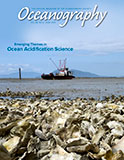Article Abstract
Coastal ocean ecosystems have always served human populations—they provide food security, livelihoods, coastal protection, and defense. Ocean acidification is a global threat to these ecosystem services, particularly when other local and regional stressors combine with it to jeopardize coastal health. Monitoring efforts call for a coordinated global approach toward sustained, integrated coastal ocean health observing networks to address the region-specific mix of factors while also adhering to global ocean acidification observing network principles to facilitate comparison among regions for increased utility and understanding. Here, we generalize guidelines for scoping and designing regional coastal ocean acidification observing networks and provide examples of existing efforts. While challenging in the early stages of coordinating the design and prioritizing the implementation of these observing networks, it is essential to actively engage all of the relevant stakeholder groups from the outset, including private industries, public agencies, regulatory bodies, decision makers, and the general public. The long-term sustainability of these critical observing networks will rely on leveraging of resources and the strength of partnerships across the consortium of stakeholders and those implementing coastal ocean health observing networks

